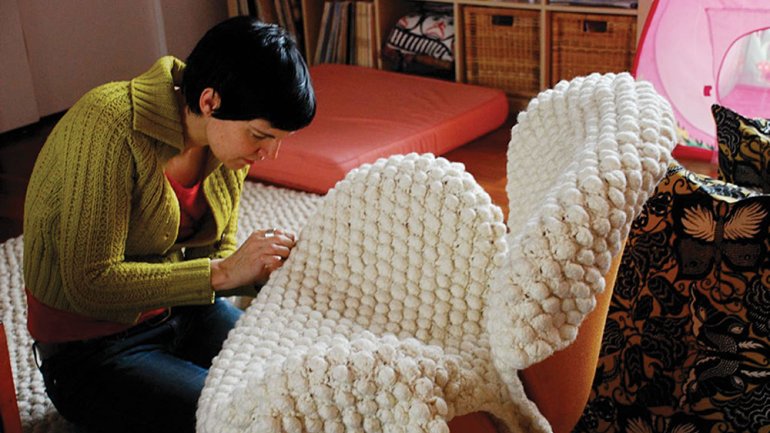Knitwear for Furniture
Knitwear for Furniture
Sinje Ollen has always been a knitter. Growing up in Germany, she knitted surreptitiously in Latin class. As a Broadway actor, she knitted backstage. As a database programmer at the New York Stock Exchange, she knitted on her coffee breaks.
She kept knitting when she started a family; and as a new mom, she realized something: She was jealous of the person who took care of her child.
“I just decided to be home and spend some time with my daughter and knit. If I am what I do, then I guess I’m a knitter.”
She created a few patterns that were picked up by Vogue Knitting magazine, though she didn’t particularly like pattern making. “You have to make so many different sizes of something. There’s so much to keep track of and so much documentation.” She started taking commissions for one-of-a-kind garments as well as developing a line of knitwear for a boutique in SoHo. But after four years, Ollen had had her second child and still wasn’t satisfied with her work situation. “I was constantly cranking out different garments for this boutique and making money,” she says, but the unsold leftovers piling up in her home from each fashion season seemed wasteful. She pulled out of the boutique in 2011.
By then, she had already had a formative experience. A few years earlier, Ollen had met Stephanie Dubsky, ceramist and exasperated mother: Dubsky’s Arne Jacobsen-designed Swan chair had been on the receiving end of a toddler with a red marker. Dubsky was torn; the chair was fine structurally, but its upholstery was ruined.
Ollen knew exactly what to do. “I said, ‘Well, that’s pretty easy. We’re just going to make a cover for the chair.’ ”
They chose a nubby yarn to match a rug in Dubsky’s home. Ollen made the cover about one and a half sizes too big so she could felt it for durability. “I just prayed that it would shrink down to the right size and that I did my math correctly.” She traded the chair covering for a set of Dubsky dinnerware. “It was my first chair, and she gave me the china before I was finished, so I was terrified that it wouldn’t come out right. But it did.”
Dubsky’s friend Julie Lasky, who is deputy editor of the New York Times Home section, saw that first chair cover and really liked it. “It just seemed like a wonderful idea,” Lasky explains, “to knit coverings for midcentury furniture – which has such strong silhouettes – and do it in a way that keeps the chairs looking presentable and really beautiful.”
Ollen had slowly realized she wanted to do more furniture covers, and Lasky suggested she give the International Contemporary Furniture Fair a try. In February 2012, Ollen committed to showing at ICFF during New York Design Week in May. Over just seven weeks, she made five prototypes to display in her booth. “It was a little nuts,” Ollen says. The preparation threw her household into chaos. Her daughter, then 7, didn’t like how hard Ollen was working. “She said, ‘You have a job: You have children. Children are a lot of work!’ ” Ollen recalls with a smile. “It was really amazing how passionate she was and how eloquent she was.”
Ollen’s fuzzy, textural additions to well-known midcentury furniture forms drew a crowd of curious design lovers to her booth at ICFF. Ollen herself is amused by the covering she made for Le Corbusier’s classic LC4 chaise longue. “Corbusier was all about mass-producing furniture and making it affordable and all that. There was a big point about it being mass-produced. Here I am, hand-knitting a cover for this mass-produced piece. That’s kind of funny,” she laughs.
In September, Ollen introduced three new designs, including a knit cushion for Aaron Thomas’ transparent Monroe chair, at the Designlush showroom in New York. And she’s looking forward to more knitting while raising her family.
“It’s the most flexible work I’ve had,” she says. “My husband decided I should be Knitting Mom. Knitting Mom is the funnest mom we’ve had.”
Andrew Zoellner is American Craft’s assistant editor.

